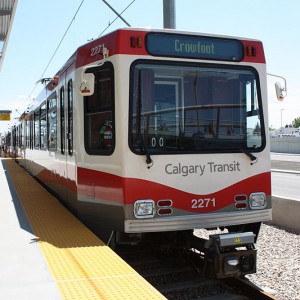
The City of Calgary is known worldwide as a pioneer in the use of renewable energy in mass transit. The C-train is Calgary’s light rail transit system, one that once was powered by coal and natural gas, but that now runs on electricity. Thousands of daily commuters board the C-Train to go to school, to work, to shop and more.
In September 2001, based on this success, the City of Calgary announced its decision to use commercial wind energy as the primary source of the C-train’s electricity. The program is called “Ride the Wind”, since the users of C-Train are actually traveling with the help of energy captured from the wind. The project was fully approved by City Council on February 12, 2001.
The highlights in the history of the project are as follows:
- Vision Quest (a power generation and wholesale marketing company) entered into a contract for green energy with Enmax;
- Enmax entered into an agreement with City Transit to deliver the wind power to the LRT;
- All emission reduction credits were transferred to City Transit via Enmax;
- Ten new wind turbines were financed, constructed, owned and operated by Vision Quest; and
- The new wind turbines started delivering clean wind power by August 31, 2001.
Calgary sources note that before the switch to wind power, the C-Train’s energy supply accounted for about 20,000 tonnes of greenhouse gases and other forms of air pollution every year, less than 1/10 of the pollution that would have resulted if all C-Train passengers had driven in their own cars. Under the Ride the Wind program, these emissions have been reduced to practically zero. This makes the C-Train one of the most environmentally friendly forms of transportation.
Calgary officials claim that the C-Train contributed greatly to solving traffic problems. There are a total of 116 light rail vehicles, and each day riders board the C-Train 189,000 times. If each commuter had travelled alone in his or her car instead of on the C-Train, the daily mileage would have amounted to 1.2 million kilometres. These car commuters would have used 107,000 litres of fuel and produced some 270,000 kg of carbon dioxide, nitrous oxide, carbon monoxide and other pollutants.
Unlike fossil fuels, wind energy is pollution-free and virtually limitless. Wind turbines have become efficient and reliable. Wind energy facilities can also be installed faster than any other large-scale electricity generating technology. Using this feasibility context, wind energy can be considered as a substitute for commonly used conventional energy sources in the transportation sector.
Case study courtesy of the UNEP Publication, Reducing Emissions from Private Cars: Incentive measures for behavioural change.